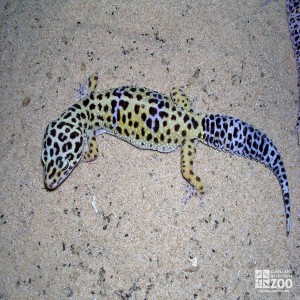Leopard Gecko
[Eublepharis macularius]

The Leopard Gecko ranges in size from 8 to 10 inches, half of which is tail. The tail is used for fat storage. The underside is whitish and the top side has a yellowish background color with multiple small dark spots or blotches on the neck, back and legs. The tail markings appear banded. The back has small, evenly spaced tubercles which give it a wart-like or knobby appearance. The young have a different pattern than the adults. They are banded with yellow and black/mauve bars. The tubercles begin at about 1 week of age. This lizard is one of the few geckos that has functional eyelids, but still it uses its tongue to clean and lubricate the eyes. They are different from most other geckos in that they do not possess adhesive toe-pads (lamellae) and are therefore unable to climb smooth surfaces. Instead they have claws which enable them to climb rocks and logs.
Location: Education Animals
Share:
Range
The Leopard Gecko's range includes the Middle East and Asia from Iran to Pakistan and India.
Habitat
The Leopard Gecko inhabits rocky outcrops in desert and mountain regions.
Conservation Status
Least ConcernPrimary Threats
Gestation
Incubation: 55-60 days.
Litter
Clutch: 2 eggs, up to 12
Behavior
They are a crepuscular species, most active at dusk while most of their day is spent under cover. Males are very territorial and will fight if kept together. Most Leopard Geckos eat their skin as they shed it.
Reproduction
Sexual maturity in Leopard Geckos occurs at 2-3 years. Breeding season usually begins about March. The male will chase the female and may then mount from either side, often resulting in minor bites on the female's abdomen and tail. The eggs are laid in pairs about six weeks after mating, with some females producing up to 6 pair in a season. Eggs are soft shelled and laid in a hole dug by the female. Although they have been laid in pairs, the eggs do not hatch simultaneously. The second egg will hatch 30-36 hours after the first. The hatchlings take 2-4 hours to emerge. Usually both of the pair are of the same sex. The young will live off the remainder of the yolk for the first 2-3 days before beginning to eat insects. Sex in these geckos is determined by the temperature at which the eggs are incubated. More females are produced at temperatures from 80 to 84 degrees F., while more males are produced at temperatures from 86 to 90 degrees F.
Wild Diet
Insects including hardbodied beetles and other invertebrates.
Zoo Diet
Crickets, mealworms.
